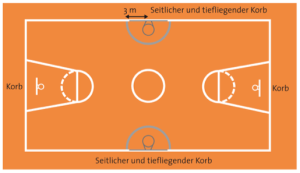HLA
CSIT – BASKIN
- Brief description
- Context and needs
- Activities and rules
- Location, environment and equipment
- Method
- Side Activities
- Target
- Impact
Baskin means something like “basket integrated” and origins from the Basketball. The game allows players with different disabilities (physical and/or mental) to play with and against each other in a dynamic way. The game originates from school sports and is becoming more and more popular.
The game relies on the important contribution of each individual in a team. The collective success depends on the efforts of each player. During a game, everyone is assigned a specific role with specific responsibilities, and therefore the “helping” idea that underlies many activities for people with disabilities can be somewhat lifted.
Duration: 4 x 10min
Number of players: 12 per team, 6 on the playing field
Playing field layout:

Rules:
Principally, the rules are based on the basketball regulations.
Each player is assigned a role (no. 1-5) and a two-digit number. The first number identifies the role, the second identifies the person. Each player is given a role that corresponds to his or her motor skills and must follow different rules. Consequently, the respective direct opponent is at the same level.
The roles:
- 5: Normally gifted player with basic basketball skills.
- 4: Disabled or non-disabled player who can use hands partially OR walk/run OR bounce regularly, but is not able to put a basket in.
- 3: handicapped player who can move the hands enough to throw a basket but cannot run fluently.
- 2: Handicapped player who can move hands enough to shoot baskets into the side and high baskets. He/she may stay in the side half circles. If he/she gets the ball, he/she must leave this zone within 10 seconds and bounce at least 2 times (also applies to wheelchair players). He/she may not be covered.
- 1: Handicapped player who stays within the lateral semicircle and can only throw. If he/she receives a ball from a teammate, he/she can optionally switch to a smaller ball (placed under small baskets) and has 10 seconds to throw. He/she must not be covered.
Both teams must put up one pivot player and at least two players with role no. 5. In order to prevent that the teams consist of too many No. 5 players (with the best skills), the sum of the roles of all players in a team add up must not exceed 23. Each team has 30 seconds to complete an action and land a basket. Defensive work by two players with the same role is allowed. If a player attacks an opponent from a lower role (e.g., a no. 4 attacks a no. 3), he commits a foul
which is penalized with two free throws. The kick-off then goes to the team that suffered the foul. If the player with role no. 3 is fouled, he may take the free throws in a side basket.
Roles No. 5 are allowed to land a maximum of three baskets per game time. There are no restrictions for the other players. Unlike basketball, there are no lines that allow three points. If the ball goes from the offensive zone back into the defensive zone, there is no sanction and no time limit to leave the half court. The 3-second rule is dropped as well as the foul bonus (from five fouls the opposing team gets two free throws) and the jump ball.
Location: basketball court (standard size)
Environment: protected zone without obstacles in the surrounding of the court
Equipment: 2 ordinary basketball hoops, 2 adjustable smaller hoops, ordinary basketballs, smaller lightweight balls, coloured adhesive tape (to mark the smaller side zones)
Baskin’s greatest advantage is clearly its adaptability. From non-disabled children with advanced skills in basketball to wheelchair users, the game can be played by all and especially with each other. Even with a very heterogeneous group, the special set of rules allows individuals to be challenged according to their ability level. In addition, this enables a flow of play that promotes fun immensely.
As the target audience of this game are bigger groups of at least 24 children it is easy to organize side activities like barbecues after the play. The children can get to know each other better over a meal together and can play outside afterwards. The food can be provided, and the organizational matters can be done by the parents and/or the school/club/the coach. Activities like this can also be extended to theme evenings concluding in an open-air cinema at mild summer evenings, for example.
According to the rules, the whole group must consist of at least 24 children. Baskin can be played by children with different kind of disabilities. The minimum requirement is a certain mobility of the arms to at least be able to throw the ball. Mobility of the legs is no requirement (e.g., wheelchair user).
Baskin is a perfect game for a bigger and very heterogenous group of children. Consequently, schools, children’s homes and larger sports teams are the perfect target group. The game can be played from an age of about 8, 9 years. However, using lower hoops and lighter balls can also enable younger children to play Baskin.
Baskin has been shown to increase self-confidence, the ability to combine duty with fun, and psychomotor skills in participants. The exchange between young people and adults has also improved.
Non-disabled people also benefit from this new activity. They learn to fit into groups where the members have different abilities. To do this, they must develop new communicative skills and allow their creativity to count. In addition, an intensive exchange is promoted on the relationship level. They also learn to share the objectives of comrades with disabilities and to appreciate differences.
PlayInc Key Aspects
Needs:
Baskin is definitely a game which puts every player in the position to express their full potential. As already mentioned, the rule set enables a development of everyone’s motorial skills. Further, the game flow boosts the self-confidence – especially of the disabled children – because they see they are also capable of play sports games with able bodied. It is also the game flow that creates a sense of belonging and therefore leads to inclusion over time.
Coach’s skills:
Apart from the skills of the coach, the game tends to regulate itself as soon as all players internalise the rules. However, game sports always offer to act as a motivator and “cheerleader” on the sideline. Of course, the coach can also direct the team or single players by giving them tips. Apart from that, the coach must use its sensitivity and knowledge about the different disabilities within the group of children to form two equal team.
Method:
A major factor in creating inclusion through sport is fun. With Baskin fun can be generated quite easily by simply playing the game. The more sophisticated set of rules can also help to teach the children the meaning and importance of rules. A successful game is only possible if everyone abides by the rules. This principle is even more important in real life.
Contact the organisation
Contact

Name: International Workers & Amateurs in Sports Confederation (CSIT)
Website: www.csit.tv
Facebook: https://www.facebook.com/csit.wsg
Instagram: https://www.instagram.com/csitwsg/
LinkedIn: https://www.linkedin.com/company/csit-worldsportsgames
